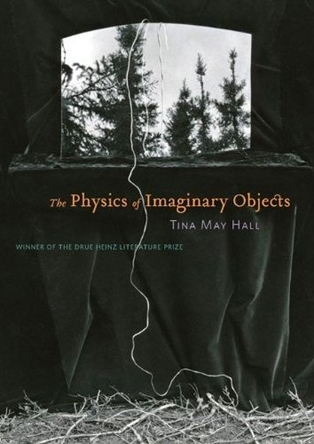‘The Physics of Imaginary Objects’
Josh Collins
Tina May Hall, “The Physics of Imaginary Objects”
University of Pittsburgh Press
2010, 147 pages, paperback, $17
 Winner of the 2010 Drue Heinz Literature Prize, Tina May Hall’s “The Physics of Imaginary Objects” fogs the border between poetry and prose. Beautifully designed, the book consists of fifteen formally innovative stories and a novella that explore, among other things, the amalgamation of human and non-human worlds. A sturdy root in the organics of Hall’s work is a lyrical sense of turning aspects, a point of view made bittersweet by the pleasure and sorrow of observing life’s changes. Permeating these stories is a modern sense of loss, a melancholic looking-back, tethered to places and people struggling to negotiate their physical environs. In terms of craft, Hall’s refined, formal playfulness gives the book its power to fascinate; but rich psychological undercurrents also animate this work with a poignant radicalness. There is a question beneath the rhythmic beauty of the language, in which objectivity and subjectivity so often overlap: where is the real division between ourselves and our surroundings?
Winner of the 2010 Drue Heinz Literature Prize, Tina May Hall’s “The Physics of Imaginary Objects” fogs the border between poetry and prose. Beautifully designed, the book consists of fifteen formally innovative stories and a novella that explore, among other things, the amalgamation of human and non-human worlds. A sturdy root in the organics of Hall’s work is a lyrical sense of turning aspects, a point of view made bittersweet by the pleasure and sorrow of observing life’s changes. Permeating these stories is a modern sense of loss, a melancholic looking-back, tethered to places and people struggling to negotiate their physical environs. In terms of craft, Hall’s refined, formal playfulness gives the book its power to fascinate; but rich psychological undercurrents also animate this work with a poignant radicalness. There is a question beneath the rhythmic beauty of the language, in which objectivity and subjectivity so often overlap: where is the real division between ourselves and our surroundings?
As strange and fragmentary as her fiction can be, Hall pulls the reader carefully into each atmosphere with captivating juxtapositions and syllabic nuances. Settings become so active and brilliant that they work on our psyches as vividly as any of the stories’ fully realized characters. In “How to Remember a Bird,” the young narrator describes an expanding hole in the center of a small town. For months now, people and things have been tumbling into the hole: a bakery has fallen in, plus a paleontologist from St. Louis who “came looking for bones,” plus objects from people’s dreams. Hall’s style here, at once transportive and grounding, punctures the crude vellum of the “real” to stir up psychological undercurrents that shape and color our emotions:
It is said that if you throw something from a dream into the hole, the dream will leave you forever and a new one will come in its place. For instance, if Bill, the diner owner, throws his apron into the hole he’ll spend his nights combing the tail of a piebald horse instead of washing endless mounds of gravy-crusted dishes. And if the horse’s spots look curiously porcelain and the comb is spongy, that is not the hole’s fault. Young girls throw their brothers’ knives and their fathers’ keys and their grandmothers’ glasses into the hole and go home to dream of sailcloth and hiking boots and bicycle tires. I’ve tried it myself. I’ve dreamed the death of Mrs. Pritchard’s son and a tree falling on the barbershop and a best friend sinking in the mud of another country, all in exchange for a hair that was left in my bed. The dreams you get are not always happy ones, merely someone else’s and by virtue of that, never nightmares.
Other stories read like meditations. Sentences and phrases repeat in the riverine course of the texts, smoothly gesturing to make the known new again. And still others offer a creepy, fairy tale–like feel. Of this grotesque and eerie camp, my favorite is “By the Gleam of Her Teeth, She Will Light the Path Before Her.” The list of characters goes like this: Father, Mother, First Daughter, Second Daughter, Only Son, the ghost of grandmother, and a night stalker in the woods who circles the house with a flashlight at mealtime. The story’s point of view roams among the family members, and the reader is presented with a constellated consciousness linked by various objects in the home, most notably, perhaps, a swan the father fashions out of a paper napkin:
Second Daughter imagines all the things that could be circling her house with a flashlight. She remembers stories from school of children being cut up and left in the forest. She remembers the wolves and bears and the abused boys who grow up to torture people found via classified ads. Mother says, “Nonsense, that light is too white to be the moon.” Father’s brown fingers crush the swan’s long throat. The grapes wither a little in their porcelain bowl, roll closer to each other for comfort.
Near the end, the story’s fairy tale vibe becomes more apparent; and Hall, once again providing an innovative response to genre expectations, intelligently avoids any Charles Perrault–type moralizing. Instead, the reader ultimately encounters a well-wrought, lyrical work of fiction that churns and re-churns themes of threat versus comfort, wilderness versus civilization, and unknown versus known.
In general, what characterizes Hall’s work is a love of language, story, and innovation. But beyond its surface of deft literary technique, “The Physics of Imaginary Objects” speaks to themes that continue to haunt and mold contemporary societies. The book deserves a wide readership for its braveness and beauty, but also for its generative, inside-out treatment of people and their fluid relationship with a strange and complex world.

Josh Collins, Fiction Editor

0 comments on “Review: Collins”